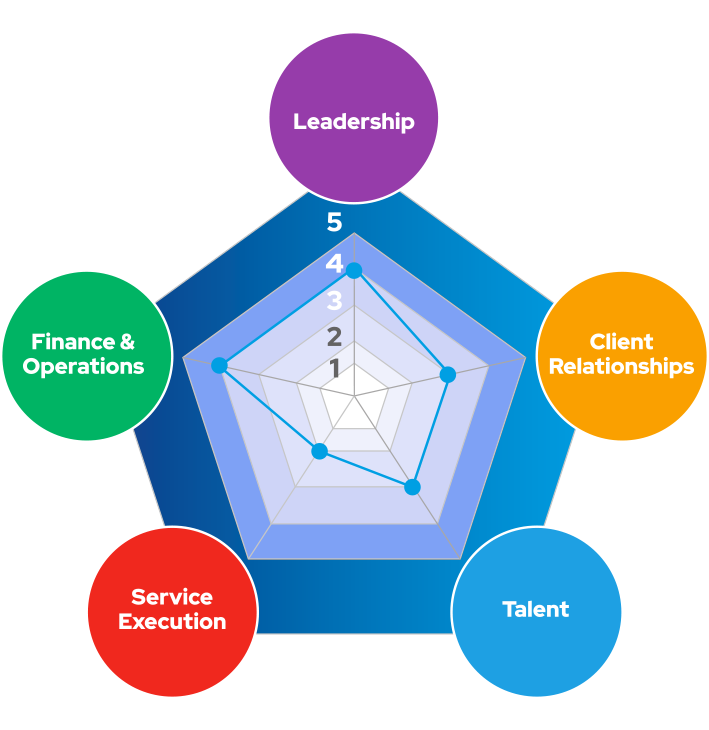Achieve professional services excellence: Benchmark, optimize and elevate your business with the industry’s leading performance framework
Achieve professional services excellence with the industry’s leading performance framework
The SPI PS Maturity Model™ guarantees higher profits.
Proven Results - No Guesswork - 18 years of data-driven insights.
The SPI PS Maturity Model™ guarantees higher profits.
Proven Results - No Guesswork - 18 years of data-driven insights.

The Professional Services Maturity Model™
A game changer for your business
In 2008, SPI developed the Professional Services Maturity Model™ as a strategic planning and management framework. It is now the industry-leading performance improvement tool used by over 50,000 service and project-oriented organizations to chart their course to service excellence.
The core tenet of the PS Maturity Model™ is PSOs achieve success through the optimization of five Service Performance Pillars™:
- Leadership
- Client Relationships
- Talent
- Service Execution
- Finance & Operations
The Professional Services Maturity Model™ is designed to help Professional Service Organizations (PSOs) understand their relative performance compared to an expansive benchmark of peers. It provides visibility into critical business processes and key performance measurements so organizations can compare, diagnose and improve their own performance. It also provides prescriptive advice so organizations can pinpoint current levels of maturity and visualize the steps required to advance to the next level.
Simply put – we identify what it takes for you to be great from the most expansive professional services industry data-set.

The Service Performance Pillars™
Our belief is that professional services organizations achieve success through the optimization of five Service Performance Pillars:
Leadership

(Vision, Strategy and Culture) (CEO)
A unique view of the future and the role the service organization will play in shaping it.
Client
Relationships

(Marketing and Sales)
The ability to communicate effectively with employees, partners and customers to generate opportunities and win deals.
Talent

(Human Resources)
The ability to attract, hire, motivate, and retain high quality employees and subcontractors.
Service
Execution

(Engagement / Delivery)
The methodologies, processes and tools to effectively schedule, deploy and measure the quality of the service delivery process.
Finance And Operations

(CFO)
The ability to manage service profit and loss and to generate revenue and profit while developing repeatable operating processes, IT applications and management controls.
Service Maturity Levels
Within each Service Performance Pillar™, SPI Research has developed key performance measurements and maturity level definitions. Maturity level characteristics:


Initiated
Heroic
The PSO is in its early stages; operating processes are ad hoc and fluid. The business environment is chaotic and opportunistic, and the focus is primarily on new client acquisition and reference building. Success depends on the competence and heroics of people in the organization, and not on the use of proven processes, methods or tools. Employees wear many hats and perform multiple roles.


Piloted
Functional
Core operating processes are starting to become repeatable. Best practices may be demonstrated in discrete functional areas or geographies but they are not yet documented and codified for the entire organization. Operational excellence and best practices may be discerned within functions but not across functions


Deployed
Project Excellence
The PSO has created a set of standard processes and operating principles for all major service performance pillars™, but renegades and hold-outs may still exist. Processes have been established to focus on effective execution with a spotlight on alignment between and across functions.


Institutionalized
Portfolio Excellence
Management uses precise measurements, metrics and controls, to effectively manage the PSO. Each performance pillar is supported by a detailed set of operating principles, tools and measurements designed to improve visibility, management control and leverage.


Optimized
Collaborative
The PSO focuses on continual improvement of all elements of the five performance pillars™. A disciplined, controlled process is in place to measure and optimize performance through both incremental and innovative technological improvements. Focus is on both quantitative and qualitative process-improvements which adapt to and take advantage of changes in the business environment.
Why Maturity Matters
the data proves it...maturity = profitability
PSOs that operate at higher maturity levels consistently outperform their peers in revenue growth, profitability, and operational efficiency. The data is clear: firms that invest in improving their maturity see direct financial benefits.
SPI’s Professional Services Maturity Model™ has tracked over 8,000 firms, and the results speak for themselves. Firms at the highest maturity levels report:
✅ 433% higher revenue growth than their Level 2 peers
✅ 265% higher profit margins
✅ 36.4% greater billable utilisation
The difference between firms that thrive and those that struggle isn’t market conditions—it’s maturity.
High-maturity organizations have:
- Stronger financial controls
- More efficient resource utilization
- Better client retention
- Data-driven decision-making

